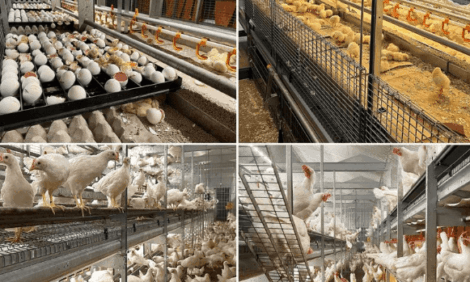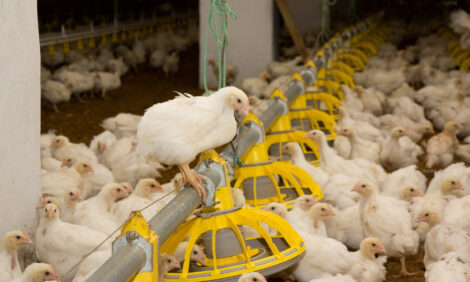



Russia Poultry and Products Semi-Annual Overview - February 2006
By the USDA, Foreign Agricultural Service - This article provides the poultry industry data from the USDA FAS Poultry and Products Semi-Annual 2006 report for Russia. A link to the full report is also provided. The full report includes all the tabular data which we have ommited from this article.Report Highlights:
Avian influenza outbreaks in Russia and neighboring countries have decreased demand for poultry meat during the last few months. Even so, Russia's poultry production is expected to grow by 15 percent in 2006 as investors continue pouring money into this sector. Poultry imports entered Russia with minimal interruptions in 2005 due to better administration of tariff rate quotas. Poultry now makes up 35 percent of the total Russian meat market. Half of all domestic poultry is traded as chilled product.
Executive Summary
Poultry production grew by 15 percent in 2005 and is expected to increase by an additional 15 percent in 2006 as heavy investments keep pouring into this sector. 87 percent of total poultry meat production is made up of broilers and half of all domestically produced chicken is traded as fresh and chilled product. Poultry now makes up 35 percent of the total Russian meat market of which 35 percent are whole birds, 37 percent are chicken leg quarters and 28 percent is deeply processed product. Most poultry imports are frozen chicken leg quarters from the United States. Imports of frozen turkey cuts are falling, while fresh and chilled turkey imports are growing –almost all from Germany. Farm poultry prices increased by 16 percent in December 2005 compared to December 2004, and prices on processed poultry increased by 21 percent over the same time period.
Production
Poultry production grew by 15 percent in 2005 and is forecast to increase by an additional 15
percent in 2006. Broilers constituted 87 percent of total domestic poultry production in
2005. Poultry analysts believe that production growth at the current rate can only continue if
ancillary industries also become more developed - feed production, processing industries,
equipment production, etc. According to industry contacts, the profitability of chicken
production is high enough at this time to cover additional costs associated with fighting avian
influenza.
In 2005, only 10 percent of total poultry output was provided by facilities where average bird
weight gain was 50 or more grams a day, birds were slaughtered at 35 days of age and the
feed conversion factor was 1.6-1.7 kilo per one kilo of weight gain. Farms where average
bird weight gain was 45-50 grams a day reached 43.5 percent of total poultry output while
farms where average bird weight gain was 30-40 grams a day provided over 11 percent.
Average annual egg production in 2005 was 340 eggs per laying hen. Feed conversion was
1.2 kilo per one dozen eggs.
Consumption
Consumer demand for poultry has noticeably decreased since AI outbreaks were first reported in the Russian Federation. As a result, poultry producers were forced to lower their prices by an average of 10 percent in late January 2006. According to recent polls, one out of every four Russian consumers admitted that they buy less poultry now than before AI outbreaks were being reported in the press. Some poultry producers say that the actual decrease in consumption caused by the AI hysteria was no more than 10 percent throughout Russia and 15 percent in large cities. They add that due to “very appealing prices” (i.e. December 1 the wholesale price of imported poultry meat in Moscow and St. Petersburg plunged 27 percent to 41 rubles per kilogram compared to 56 rubles in April-June of last year) sales of inexpensive chicken meat even increased. Other Russian poultry producers have stated that their sales have dropped by as much as 20 percent as a result of AI outbreaks.
Trade
The forecast of poultry imports in 2005 and 2006 increased in comparison with the previous
report due an enlargement to Russia’s poultry import quota. In addition, imports of poultry
products not limited by quota were higher than expected, as were estimated smuggled
Poultry meat now makes up 35 percent of total Russian meat market. Of that 35 percent,
one-third is whole birds, one-third chicken leg quarters and 28.5 percent is deeply processed
products. 50 percent of domestically produced chicken is now traded as fresh and chilled
product. According to Russia’s Customs Service, Russia imported 1,161,800,000 metric tons
of poultry meat (Chapter 0207) from January-November 2005 worth $743.5 million.
The majority of poultry imports are frozen chicken leg quarters from the United States.
Imports of frozen turkey cuts are falling, while imports of fresh and chilled turkey are
growing – almost all is coming from Germany.
A number of Russian poultry plant managers announced that they began lowering offer
prices of poultry meat by 10 percent in late January 2006 as a result of the noticeable
decline in poultry consumption. According to market analysts, by the end of 2006, poultry
meat prices might go down by as much as 25 percent. In addition, experts said that tougher
competition in the market was also a factor in recent price reductions. Because the decline
in consumer demand for poultry has affected all regions, large quantities of poultry meat in
provincial areas are being sold at 44-47 rubles per kilogram: mainly in the south of the
country and the periphery of Moscow oblast. According to market players, poultry plants
may be forced to cut prices even further and takes some losses since production volumes
continue to increase and have already saturated the market.
According to the latest statistics provided by the Russian Ministry of Agriculture, farmgate
poultry prices increased by 15 percent in December 2005 compared to December 2004, and
processed poultry prices increased by 21 percent over the same time.
Stocks
Poultry stocks are high due to lower consume r demand for poultry. Stocks have been steadily increasing since the fall of 2005, shortly after AI outbreaks first began being reported in the media. In addition, poultry meat sales typically decrease around the New Year and Christmas, as Russians prefer to serve red meat products for important holidays. Domestic producers were forced to lower their prices in order to get rid of their product since most of them lack sufficient cold storage facilities. These producers trade mostly fresh and chilled poultry.
Policy
The Russian Ministry of Economic Development and Trade (MEDT) allocated an additional
40,000 metric tons of poultry quota to eligible importers in 2005 after Prime Minister Mikhail
Fradkov signed a decree approving the increase in quota of total poultry imports from 1.05
million metric tons to 1.09 million tons. The U.S. portion of the quota was increased from
771,900 to 811,900 metric tons. The additional quota volume was allocated to existing
Russian importers based on historical import amounts.
According to Russian Customs data, almost 200,000 metric tons of poultry meat was shipped
from Kaliningrad to Russia duty free. Since Kaliningrad is a duty free zone, poultry
shipments from there to Russia’s “mainland” are not subject to import quota restrictions.
The Russian Poultry Union has been lobbying hard for the federal government to clamp down
on imports via Kaliningrad and has sent MEDT a draft federal law prohibiting all imports of
Chapter 0207 within the free zone regime in order to keep poultry imports within the quota.
AI Epizootic Situation
Russian veterinary authorities announced during the recent Beijing Forum that Russia is free
from AI and that there are no current cases of bird flu in Russia. In addition, Russian
officials stated that all of their poultry farms are AI-free. The largest layer hen production
facility in Kurgan oblast was closed in October 2005 after AI struck. 460,000 birds were
culled shortly afterwards.
The Russian delegation announced that Moscow would allocate over $40 million to fight and
prevent AI in Russia and the neighboring countries. The first AI case of H5N1 subtype was
positively serotyped in Novosibirsk oblast August 1, 2005 and shortly afterwards AI
outbreaks in backyard poultry and wildfowl were reported in other regions including Tyumen,
Omsk and Kurgan oblasts, Altay kraiy, Tula, Tambov, Chelyabinsk and Astrakhan oblasts and
the Kalmyk Republic. The only commercial production facility hit by AI was the Utyatskaya
layer facility in Kurgan oblast.
To date, there have been no officially confirmed human cases of AI in Russia. The Ministry of
Health recently implemented new measures to fight the spread of AI such as requiring all
passengers flying from Eastern countries to pass through a chloride walkway soaked in
disinfectants. In addition, passengers are expected to fill out a new form describing how
they felt after their trip. These measures are mainly applied to flights coming from Turkey.
A doctor will now board every flight arriving from Turkey to conduct a visual examination of
each passenger. If any passenger exhibits symptoms of influenza, the passenger will be
rushed to an area hospital for further evaluation.
Prime Minister Fradkov told journalists at the end of January that the Russian government
would soon issue a decree introducing a new set of measures aimed at preventing and
controlling a possible outbreak of AI in the spring when migrating birds return. Vaccinations
will also play a role in fighting the spread of AI in Russia. According to Federal Veterinary
and Phytosanitary Surveillance Service (VPSS) officials, there is no need to vaccinate
chickens in commercial facilities since they have the means to apply ordinary biosafety
measures. Instead, they will direct their efforts to domestic, backyard birds that are not able
to avoid contact with potentially-AI infected waterfowl. Ministry of Health officials announced
that 100 million vaccines would be produced by the spring.
Newcastle Disease Reported in Southern Russia
On February 6, a state of emergency was declared in Karabudakhentskiy district of Dagestan in connection with the death of over 300,000 layer hens due to Newcastle disease. The dead birds were found in private yards and in the Eldam Poultry Plant on January 25. The Emergency Committee of Dagestan is expected to provide more details once they complete their investigation.
Border Control Tightens
During the last few months, Russian customs officials have been confiscating larger and larger amounts of imported meat products (including poultry) under the banner of protecting human health. In November 2005, the Russian Ministry of Agriculture announced that it had placed a ban on all meat and plant products from Poland due to out-of-control smuggling and fraud. According to VPSS, Polish suppliers of meat have been engaging in smuggling and the falsification of veterinary documentation for years. In doing so, they have been “consistently violating” Russian veterinary legislation. In addition, Russian authorities ordered the suspension of all meat and dairy imports from Ukraine in January 2006 because of “numerous violations” of Russian veterinary laws by Ukrainian exporters.
Marketing
The biggest poultry exporter in Thailand, Charoen Pokphand Foods, has announced plans to build several poultry facilities in the Russian Federation in 2006, including in Moscow oblast. Representatives of various Russian ministries recently agreed to limit meat exports from Kaliningrad to other Russian regions. Ministry of Agriculture representatives said that this
List of Articles in this series
To view our complete list of 2006 Poultry and Products Semi-Annual reports, please click hereSource: USDA Foreign Agricultural Service - February 2006








